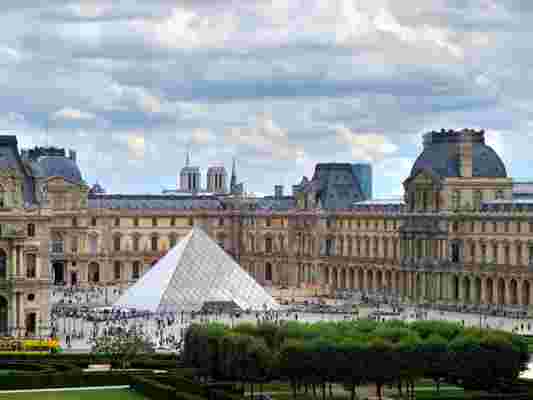In honor of architect I.M. Pei’s 100th birthday, we’re diving into the history of the Louvre : a cultural hub that precedes him by some 700 years, but which owes much of its present vibrancy to his 1980s renovations.
First, though, let’s step back in time. The museum dates back to the 12th century, when it was built as a fortress—a fact not many would first associate for the eventual home of the Mona Lisa.
Its halls were once home to a strange royal ritual :
Before the Louvre was a museum, it was a royal residence, home to several generations of kings. King Henry IV was among them—and he enacted a kingly ritual known as the Royal Touch in the Louvre’s halls.
French royals at the time were thought to have god-given power to rule. One such perk of divine backing? The ability to heal illnesses—such as swollen lymph nodes, a side effect of tuberculosis—with a mere touch. And so, Henry IV received tuberculosis sufferers in one of the Louvre’s halls, anointing the sick with holy water while intoning, “Le roy te touché, dieu te guerit” (“The king touches you, God is healing you”).
It pioneered the concept of public art :
Modern-day Parisian artists, who spend hours sketching at the Louvre, may colloquially claim to live there. But in the 17th and 18th centuries, artists really did live in the Louvre.
Before Louis XIV assumed the throne, several generations of royals had called the Louvre home. But when the Sun King chose to move to Versailles in the late 17th century, it allowed artists to move in. There, they exchanged ideas, copied paintings, and worked on their own projects.
The building soon became a nucleus for the art world. After the French Revolution (1789-1799), the Louvre was officially converted from a palace into a public museum. Back then, allowing the public access to great works of art was a novel concept—one that evidently had sticking power. The museum ran on the ten-day week of the French revolution: the first six days of the week were for artists only, the next three offered access to the public, and the last day was reserved for repairs.
Pei’s glass pyramid was meant to mesh with the landscape—not fight with it:
Cleary, the Louvre has a rich history—and to modernize a building with such a significant past is no small undertaking. So in 1983, when French president Francois Mitterand called on Pei to revive the ailing building, the architect took some time pondering his design.
Pei kept the project a secret from his own team for four months, and took several surreptitious trips to the museum before drawing up blueprints. When he finally put pen to paper, his plans included a new entrance, a network of rooms to make museumgoing more pleasant (an information center, a cafeteria), and, famously, the glass pyramid.
Parisians at the time were scandalized when the design was unveiled. Pei’s pyramid was a “gigantic, ruinous gadget,” as one New York Times critic wrote in 1985 . The overwhelming sentiment at the time was that Pei's pyramid was a modernist eyesore jutting starkly against its baroque surroundings.
But perhaps Pei’s critics would have been gentler had they known how meticulously he tried to marry his design to its landscape.
As Michael Flynn, an architect from Pei’s team, reminisced to Architect Magazine , Pei wanted the glass to be “super-clear”—so if you peered through it, the glass wouldn’t “alter your perception of the color of the existing buildings.” Clear glass doesn’t sound like a tall order, but at the time, most glass used in buildings had a greenish tint. Finding perfectly clear glass was “a lot of legwork,” said Flynn.

When designing the pyramid, architect I.M. Pei was mindful to keep the structure below the surrounding buildings, ensuring the modern addition would be as unobtrusive as possible.
Designing the framework was no less laborious. Pei wanted to match the metal to the color of the roofs of its surrounding buildings. As it turned out, those buildings sported 11 shades of gray—so, long conversations ensued about which hue to choose, too.
Finally, the size. A study was conducted on the height of the pyramid in relation to the existing buildings. The pyramid, per Pei, was designed to fall beneath a certain line, so it wouldn’t stick out above rooftops. The architect really did want the piece to be as unobtrusive as possible—which didn’t stop the controversy, but does help to contextualize it.

Leave a Reply